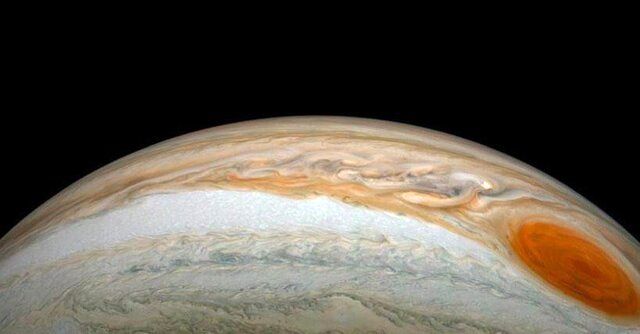تصاویر اعجابانگیز از سیاره مشتری

Jupiter and Its Galilean Moon
-

Jupiter’s moon Io floats above the cloud tops of the gas giant below in this image captured on January 1, 2001, by NASA’s Cassini spacecraft. The image is deceiving: Io and Jupiter’s clouds are 350,000 kilometers—roughly two and a half Jupiters—apart. Io is the size of Earth’s moon, and Jupiter has a diameter that is 11 times larger than Earth’s. #
NASA / JPL / University of Arizona -

Swirling clouds are visible in the upper atmosphere of Jupiter, as viewed by the Juno spacecraft in 2020. #
CC BY NASA / JPL-Caltech / SwRI / MSSS / Kevin M. Gill -

A closer view of Io, made by the Galileo spacecraft on March 29, 1998, with Jupiter’s cloud tops in the background. Image assembled from infrared-, red-, green-, and violet-filtered images #
CC BY NASA / JPL-Caltech / Kevin M. Gill -

An active volcanic eruption on Jupiter’s moon Io was captured in this image taken on February 22, 2000 by Galileo. Tvashtar Catena, a chain of giant calderas, was the location of an energetic eruption caught in action in November 1999. A dark, L-shaped lava flow to the left of the center in this more recent image marks the location of the eruption. White and orange areas on the left side of the picture show newly erupted hot lava, seen in this false color image because of infrared emission. The two small bright spots are sites where molten rock is exposed to the surface at the toes of lava flows. The larger orange-and-yellow ribbon is a cooling lava flow that is more than 37 miles long. #
NASA / JPL / University of Arizona -

This dramatic image of a volcanic eruption taking place on Io was made by the Long Range Reconnaissance Imager aboard New Horizons on February 28, 2007, from about 1.5 million miles away. This processed image provides an amazing view of the enormous 180-mile-high plume from the volcano Tvashtar, near Io’s north pole. #
NASA / Johns Hopkins University Applied Physics Laboratory / Southwest Research Institute -

This Voyager 1 image mosaic shows Io’s south polar region, including Haemus Mons, a 32,000-foot mountain at left. Elsewhere, much flatter volcanic plains, eroded volcanic plateaus, and crater-like calderas dominate the scene. #
NASA / JPL / USGS -

Jupiter’s moon Io casts its shadow on the planet in this dramatic image from NASA’s Juno spacecraft, taken on September 11, 2019. As with solar eclipses on the Earth, within the dark circle racing across Jupiter’s cloud tops one would witness a full solar eclipse as Io passes in front of the Sun. Juno’s close proximity to Jupiter provides an exceptional fish-eye view, showing a small fraction near the planet’s equator. The shadow is about 2,200 miles wide, approximately the same width as Io, but appears much larger relative to Jupiter. #
CC BY NASA / JPL-Caltech / SwRI / MSSS / Kevin M. Gill -

This image of the crescents of volcanic Io and more sedate Europa is a combination of two New Horizons images taken on March 2, 2007, about two days after the space probe made its closest approach to Jupiter. The composite image shows the relative positions of Io and Europa, which were moving past each other during the image sequence. Although the moons appear close together in this view, a gulf of 490,000 miles separates them. Io’s night side is lit up by light reflected from Jupiter, which is off the frame to the right. Europa’s night side is dark, in contrast to Io, because this side of Europa faces away from Jupiter. Here Io steals the show with its beautiful display of volcanic activity. Three volcanic plumes are visible. Most conspicuous is the enormous, 190-mile-high plume from the Tvashtar volcano at the 11-o’clock position on Io’s disk. Two much smaller plumes are also visible, from the volcano Prometheus, at the 9 o’clock position on the edge of Io’s disk, and from the volcano Amirani, seen between Prometheus and Tvashtar. The Tvashtar plume appears blue because of the scattering of light by tiny dust particles ejected by the volcanoes, similar to the blue appearance of smoke. #
NASA / Johns Hopkins University Applied Physics Laboratory / Southwest Research Institute -

The surface of Jupiter’s icy moon Europa looms large in this newly reprocessed color view, made in 2014 from images taken by NASA’s Galileo spacecraft in the late 1990s. The scene shows the stunning diversity of Europa’s geology. Long, linear cracks and ridges crisscross the planet’s surface, interrupted by regions of disrupted terrain where the ice crust has been broken up and refrozen into new patterns. Areas that appear blue or white contain relatively pure water ice, while reddish and brownish areas include non-ice components in higher concentrations. #
JPL-Caltech / SETI Institute / NASA -

This image shows a closer view of the ice-rich crust of Europa. Seen here are crustal plates ranging up to 8 miles across, which have been broken apart and “rafted” into new positions, superficially resembling the disruption of pack ice on polar seas during spring thaws on Earth. The size and geometry of these features suggest that motion was enabled by ice-crusted water or soft ice close to the surface at the time of disruption. This picture was taken by the Solid-State Imaging system on board Galileo on February 20, 1997. #
NASA / JPL / ASU -

New Horizons took this image of Europa rising above Jupiter’s cloud tops on February 28, 2007. #
NASA / Johns Hopkins University Applied Physics Laboratory / Southwest Research Institute -

The surface of Europa features a widely varied landscape, including ridges, bands, small rounded domes, and disrupted spaces that geologists called “chaos terrain.” This newly reprocessed image, released on May 1, 2020, was taken by Galileo on September 26, 1998, and reveals details of diverse surface features. The long, linear ridges and bands are thought to be related to the response of Europa’s icy surface crust as it is stretched and pulled by Jupiter’s strong gravity. This image depicts an area about 180 miles across. #
JPL-Caltech / SETI Institute / NASA -

The Hubble Space Telescope captured the moon Ganymede, just before it ducked behind Jupiter, on April 9, 2007. #
NASA, ESA, and E. Karkoschka, University of Arizona -

NASA’s Juno mission captured these elaborate atmospheric jets in Jupiter’s northern mid-latitude region. This detailed, color-enhanced image reveals a complex topography in the planet’s cloud tops. If you look closely, relatively small, bright, “pop-up” clouds—which rise above the surrounding features—stand out at the tops and edges of the swirling patterns, while the darker areas nearby reveal greater depth. Citizen scientist Kevin M. Gill processed this JunoCam image, which was taken on April 10, 2020. #
CC BY NASA / JPL-Caltech / SwRI / MSSS / Kevin M. Gill -

An image of the Tiamat Sulcus region on Jupiter’s moon Ganymede, taken just after local sunrise, as seen by the spacecraft Galileo in July of 1998. The illumination from such a low sun angle highlights the grooved topography of Tiamat. Furrows and fractures are apparent in the surrounding dark terrain also. #
NASA / JPL / Brown University -

A full disk view of Ganymede on March 30, 1998, assembled using infrared-, green-, and violet-filtered images. Composed of rock and ice, Ganymede is the largest moon in our solar system. It is even larger than the planet Mercury. #
CC BY NASA /JPL-Caltech / Kevin M. Gill -

Three moons and their shadows parade across Jupiter on January 24, 2015, as seen by the Hubble Space Telescope. Europa has entered the frame at lower left. Slower-moving Callisto is above and to the right of Europa. Fastest-moving Io is approaching the eastern limb of the planet. Europa’s shadow is toward the left side of the image, and Callisto’s shadow to the right. #
NASA, ESA, and the Hubble Heritage Team, STScI / AURA -

Jupiter’s Great Red Spot, as viewed by the Juno spacecraft in 2019 #
CC BY NASA / JPL-Caltech / SwRI / MSSS / Kevin M. Gill -

Callisto was revealed by the Voyager cameras to be a heavily cratered and hence geologically inactive world. This mosaic of Voyager 1 images, obtained on March 6, 1979, from a distance of about 400,000 kilometers, shows surface detail as small as 10 kilometers across. The prominent old impact feature Valhalla has a central bright spot about 600 kilometers across, probably representing the original impact basin. The concentric bright rings extend outward about 1,500 kilometers from the impact center. #
NASA / JPL -

This mosaic of two images shows an area within the Valhalla region on the surface of Callisto. The smallest details that can be discerned in this picture are knobs and small-impact craters about 170 yards across, as seen by NASA’s spacecraft Galileo on November 4, 1996. #
NASA / JPL / ASU -

One moment in an ancient, orbital dance is caught in this picture taken by NASA’s Cassini spacecraft on December 7, 2000, just as two of Jupiter’s four major moons, Europa and Callisto, were aligned with each other and the center of the planet. #
NASA / JPL / University of Arizona






ارسال نظر